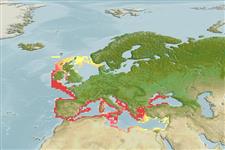Common names from other countries
Bivalvia |
Mytilida |
Mytilidae
Environment: milieu / climate zone / depth range / distribution range
Ecology
Benthic; depth range 125 - 200 m (Ref. 2754). Tropical, preferred 16°C (Ref. 107945); 61°N - 30°N, 11°W - 36°E
Northeast Atlantic, the Mediterranean and the Black Sea. Introduced to the Arctic, Indian and Pacific Oceans.
Length at first maturity / Size / Weight / Age
Maturity: Lm ? range ? - ? cm Max length : 16.5 cm SHL male/unsexed; (Ref. 109255)
The shell lacks radiating ridges containing three small teeth below the beak. The exterior is often bluish black with the interior portion being dull blue (Ref. 310).
Found in warmer waters (Ref. 95344). Occurs in quiet waters and lives lower in the intertidal zone attached to rock substrates (Refs. 310, 125090). Inhabits muddy and sandy bottoms (Ref. 125090). Smaller individuals move to the outer edge of the colony (Ref. 310). Feeds on a variety of phyto- and zooplankton (Ref. 112108).
Life cycle and mating behavior
Maturity | Reproduction | Spawning | Eggs | Fecundity | Larvae
Members of the class Bivalvia are mostly gonochoric, some are protandric hermaphrodites. Life cycle: Embryos develop into free-swimming trocophore larvae, succeeded by the bivalve veliger, resembling a miniature clam.
Demir, M. 2003. (Ref. 2754)
IUCN Red List Status
(Ref. 130435: Version 2025-1)
CITES status (Ref. 108899)
Not Evaluated
Not Evaluated
Threat to humans
Human uses
Fisheries: commercial
FAO - Aquaculture: production, species profile; Fisheries: landings, species profile | FishSource | Sea Around Us
Tools
More information
Life cycleReproductionMaturityFecunditySpawningEggsEgg developmentLarvae PhysiologyOxygen consumption
Human RelatedStamps, coins, misc.
Internet sources
Estimates based on models
Preferred temperature
(Ref.
115969): 5.5 - 18, mean 11 (based on 176 cells).
Resilience
High, minimum population doubling time less than 15 months (K=0.1-1.82).
Prior r = 0.50, 95% CL = 0.33 - 0.75, Based on 2 data-limited stock assessments.
Fishing Vulnerability
Low vulnerability (20 of 100).
Climate Vulnerability
Moderate to high vulnerability (53 of 100).
Nutrients : Calcium = 149 [71, 228] mg/100g; Iron = 8.53 [1.95, 15.11] mg/100g; Protein = 9.88 [8.64, 11.12] %; Omega3 = 0.313 [0.202, 0.423] g/100g; Selenium = 61 [50, 72] μg/100g; VitaminA = 0 μg/100g; Zinc = 2.04 [0.56, 3.51] mg/100g (wet weight); based on
nutrient studies.
